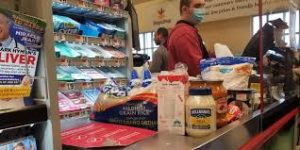
“After 9-11, one of the things we saw we saw was an increase in sales to supermarkets because people weren’t eating out. The same thing is happening now,” said Matthew Caito, a faculty lecturer on logistics and supply management at Butler.
His father and uncle started Indianapolis-based Caito Foods in the 1960s. The family sold the business in 2017 to Michigan-based SpartanNash (Nasdaq: SPTN).
The national distributor and retail grocery store chain still delivers fresh produce to retail grocery stores under the Caito name.
Prior to teaching, Caito worked in operations and administration for the family business. He says the distribution chain is facing something like never before.
“One of the things you have to think about is that in typical America, anywhere from 45 to 55% of the meals are eaten outside of the house. So, when you take that away and the restaurants are closed, where do people go to buy their food? They’re going to go to the supermarket.”
Caito says beyond the initial run on grocery stores for toilet paper and water, grocery stores are now dealing with higher, ongoing demand since restaurants are mostly closed.
“I don’t think there’ll be any shortages of food, but you’ll see an emphasis on staple foods,” Caito explains. “If you’re manufacturing a certain line of foods, you’re going to focus on the high sellers, the key sellers, and really going to get to as much equilibrium or stability as you can in your production.”
Stability and consistency, two words that Caito says are vital in the food distribution sector.
“What I learned in my career; we really have to focus on making sure we have our supply chain very consistent.”
Caito says supply chain disruptions often stem not from a shortage of materials, but a broken link in the chain.
“Any disruption in the scheduling…even a couple of days…all of a sudden we have to rush some product through the system. It takes us weeks to catch up just because we get out of the pattern.”
